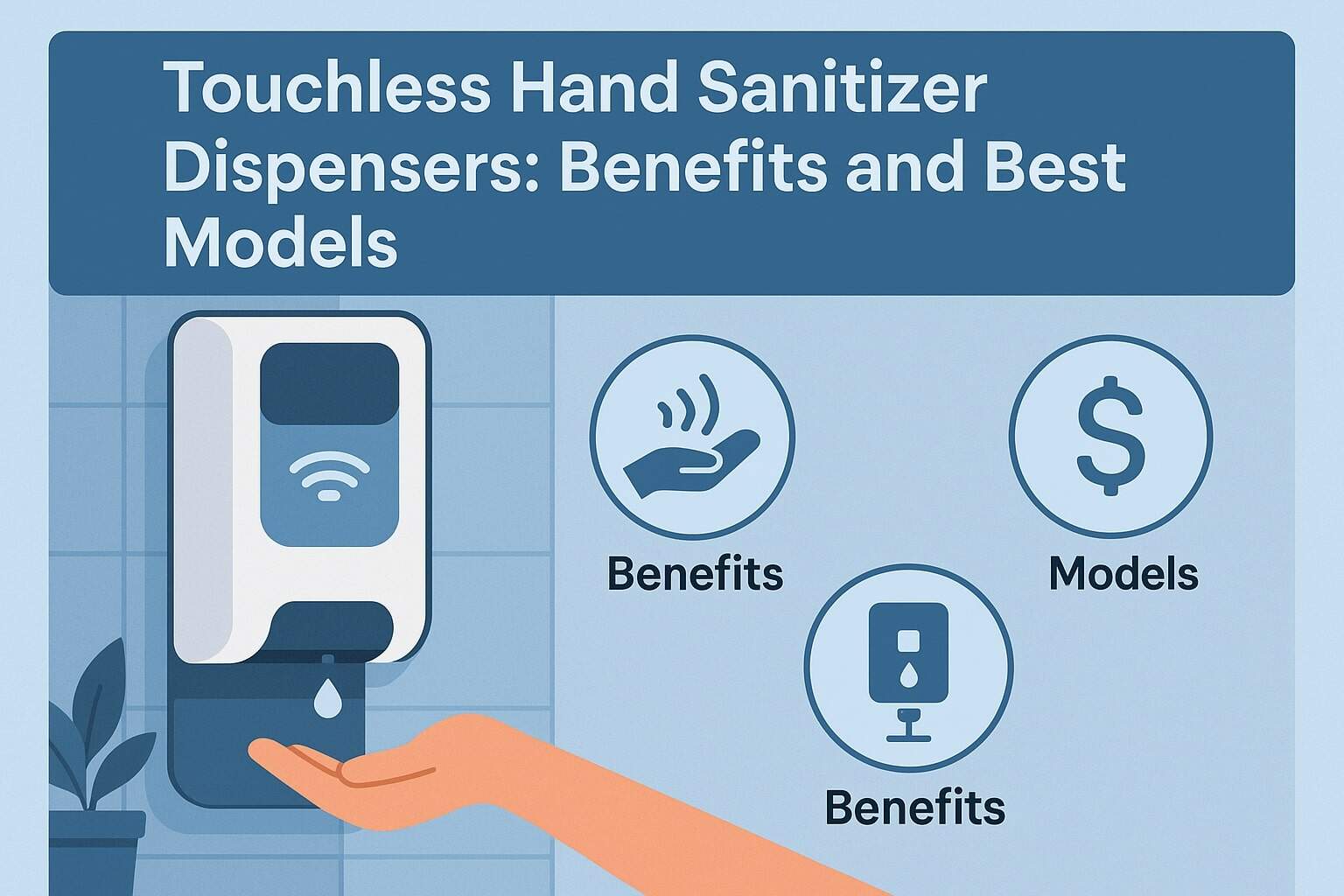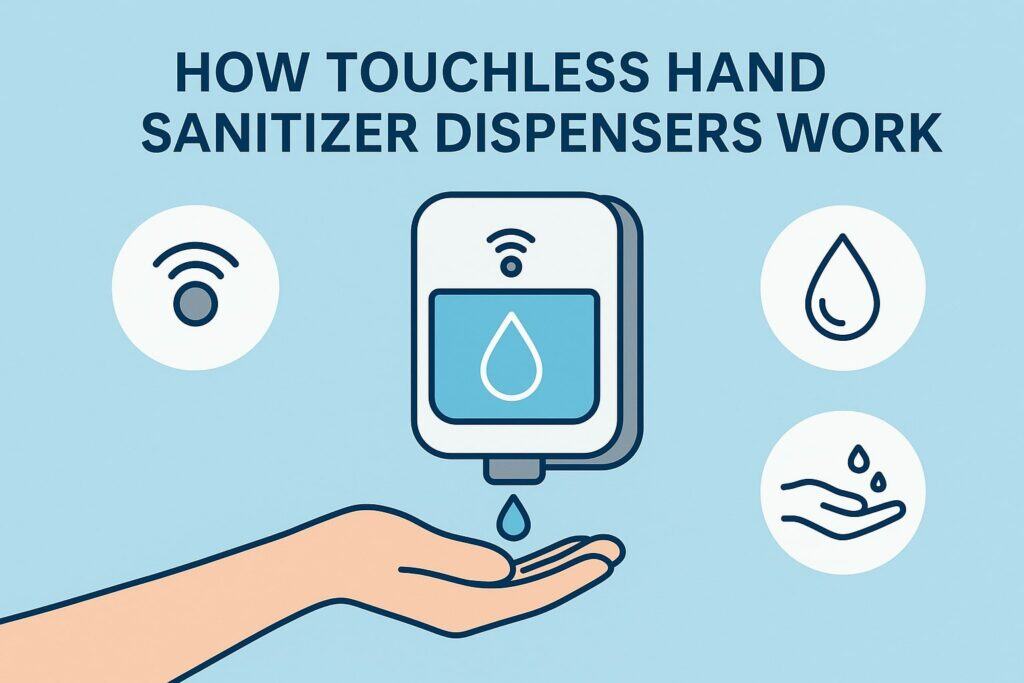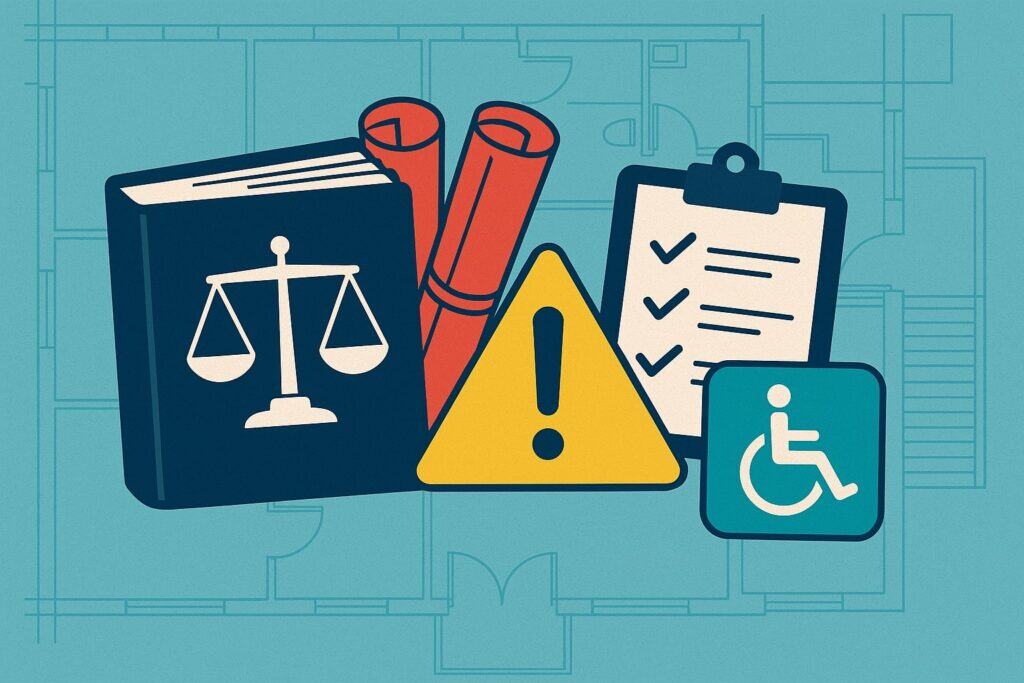
By myhandsanitizershop October 16, 2025
Touchless hand sanitizer dispensers lower the risk of cross-contamination because hands never touch a pump, lever, or surface. That seemingly small detail matters in high-traffic U.S. environments—offices, schools, hospitals, retail, airports—where dozens or even thousands of people use the same fixtures daily.
Touchless systems also deliver controlled doses of sanitizer, which improves user experience and reduces waste. For U.S. employers, facility leaders, and safety managers, touchless hand sanitizer dispensers are an easy, visible way to reinforce hand hygiene policies alongside soap-and-water options.
The Centers for Disease Control and Prevention (CDC) recommends alcohol-based sanitizer when soap and water are unavailable and specifies at least 60% alcohol for effectiveness—so your dispenser and refill choices should reflect that baseline.
Keeping dispensers stocked, accessible, and in the right locations is as important as choosing the device itself. The result is a more hygienic environment, better compliance, and fewer complaints about broken or empty pumps.
How Touchless Hand Sanitizer Dispensers Work (Sensors, Dosing, and Power)

Modern touchless hand sanitizer dispensers use infrared or similar proximity sensors to detect hands and trigger a metered dose of gel, foam, or liquid sanitizer. The goal is consistent, no-mess dispensing with minimal lag so users don’t “double dip” or touch the unit.
Most commercial models run on replaceable alkaline batteries or sealed battery packs. A growing category uses “energy-on-the-refill” (a small cell embedded in each cartridge) to eliminate routine battery swaps and reduce battery waste in U.S. facilities.
Premium systems may add connected features: refill-low indicators, battery alerts, and optional compliance monitoring dashboards for healthcare or enterprise campuses.
Features that matter in daily use include: (1) dose size options to balance efficacy and cost; (2) lockable covers to deter tampering; (3) sealed refills with new pumps to reduce contamination; and (4) fast service access so custodial teams can swap cartridges quickly during rounds.
GOJO’s PURELL® ES8 and CS8 platforms are well-known examples of energy-on-the-refill designs. Tork’s Intuition® S4 family highlights sealed bottles with a new pump per refill, which helps lower contamination risk and keeps dosing consistent over the life of the cartridge.
U.S. Codes, Safety, and Accessibility: What You Must Know Before You Install

If you plan to install touchless hand sanitizer dispensers in U.S. facilities, confirm compliance with three pillars: CDC hygiene guidance, ADA accessibility, and fire/life-safety codes often referenced by The Joint Commission and NFPA 101.
From a hygiene perspective, stock alcohol-based sanitizer (ABHS) of at least 60% alcohol when soap and water aren’t available. Avoid “topping off” partially used refills—a CDC safety note—because refilling can contaminate product or compromise dispenser function.
Accessibility matters too. Under the 2010 ADA Standards, most operable parts such as dispenser activators should be within reachable ranges—commonly no higher than 48 inches to the highest operable part when mounted for a forward or side reach. That keeps touchless hand sanitizer dispensers usable for wheelchair users and children.
Finally, in healthcare settings and many institutional corridors, NFPA 101–aligned rules govern where ABHR can be installed, spacing between units, maximum capacity per container, and corridor width (e.g., many healthcare corridors must be at least 6 feet wide and dispensers spaced several feet apart).
Always coordinate with your AHJ (Authority Having Jurisdiction) and your facility’s life-safety plan before large rollouts.
Placement Strategy: Getting Location and Height Right the First Time

Strategic placement of touchless hand sanitizer dispensers determines whether people actually use them. Place wall units at decision points and “in-and-out” zones: main entries, elevator banks, restroom exits, breakrooms, cafeterias, nurse stations, and classroom doors.
In healthcare, add units just inside patient rooms and at the point of care, following your infection prevention team’s map and fire code allowances. For accessibility, mount the highest operable part at or below 48 inches above the finished floor in most scenarios, and ensure clear floor space for forward or side approaches.
Keep units away from ignition sources and follow corridor spacing rules in clinical settings to satisfy NFPA 101 and local fire code interpretations. If you deploy freestanding stands in lobbies or storefronts, choose stable, ADA-friendly designs and avoid blocking egress paths or protruding more than allowed.
This is especially important in facilities that accept Medicare/Medicaid funds and follow CMS-adopted Life Safety Code requirements. In all cases, pair touchless hand sanitizer dispensers with clear signage and periodic reminders to encourage use without creating clutter.
Refill Chemistry: What to Put in Your Touchless Dispenser
The best touchless hand sanitizer dispensers perform only as well as the refill inside. For U.S. environments, pick refills labeled as alcohol-based hand rub (ABHR) with ≥60% ethanol or isopropanol.
This matches CDC guidance and aligns with most hospital infection-prevention programs. Choose sealed cartridges to reduce contamination and ensure a clean pump each time you change a refill.
This matters in schools, restaurants, and clinics where misuse or backfilling can happen if refills are not locked down. For sensitive areas, consider fragrance-free formulas and skin conditioners to support frequent use.
Foam refills tend to deliver a pleasant feel and reduce drips on floors; gels may offer better cling in quick-move areas like lobbies. Confirm compatibility between the dispenser platform and approved refills—many brands use keyed systems to prevent mis-fills.
For safety, follow storage limits for alcohol-based products and avoid storing large volumes outside approved cabinets. When in doubt, ask your risk management or EH&S team to review Safety Data Sheets and fire code implications for your building.
Maintenance, Monitoring, and Total Cost of Ownership
Touchless hand sanitizer dispensers should be simple for custodial teams to service. Favor front-loading designs with large sight windows, one-step latch releases, and keyed locks. Choose platforms with visible “low refill” and “low battery” cues so staff can top up before peak traffic.
Some ecosystems offer optional compliance and telemetry modules that generate alerts when a unit is empty or underused—useful for hospitals and distributed campuses. On power, evaluate battery life claims and the cost of replacements.
For example, certain high-capacity electronic dispensers advertise long runtimes—tens of thousands of dispenses per set of batteries—while energy-on-the-refill platforms eliminate battery inventory altogether and reduce battery waste.
Beyond consumables, factor in spill control, floor cleaning, and dispenser durability. A cracked cover that triggers false activations wastes the product. Better housings reduce vandalism and accidental bumps in busy corridors or locker areas.
A smart purchasing program considers all-in cost over 3–5 years: device price, refills, batteries, labor, and downtime.
The Best Touchless Hand Sanitizer Dispensers (Editor’s Picks for 2025)
Below are widely used, U.S.-available touchless hand sanitizer dispensers with strong ecosystems, reliable refills, and good serviceability. Always confirm local code and ADA mounting requirements before purchase.
PURELL® ES8 Touch-Free Dispenser (Wall or Stand)
Why it stands out: The ES8 platform from GOJO uses energy-on-the-refill cartridges, so every new refill comes with a built-in power cell. That means no manual battery replacements, fewer battery procurement hassles, and measurable battery-waste reduction compared to many traditional touchless systems.
Facilities teams appreciate fast, tool-free servicing and a robust refill catalog (gel and foam ABHR, plus compatible soaps in ES8 soap units for sink zones). Optional SMARTLINK® modules enable activity logging and alerts, which can support compliance programs in healthcare and enterprise.
For organizations standardizing on PURELL Advanced formulations and needing touchless hand sanitizer dispensers across lobbies, hallways, and cafeterias, ES8 is a proven, scalable option.
PURELL® CS8 Touch-Free Dispenser (Wall)
Why it stands out: CS8 is another GOJO system with energy-on-the-refill technology and fast refill swaps. It’s a reliable choice when you want touchless dispensing with easy visual checks of fill level and consistent dosing.
Healthcare teams also use CS8 variants for soap or surgical scrub—useful if you want the same industrial design language across sinks and sanitizer stations. If you already stock PURELL refills through national distributors, CS8 units can simplify procurement and training while keeping a uniform look.
Tork Intuition® S4 Touch-Free Skincare/Sanitizer Dispenser
Why it stands out: Tork’s Intuition S4 family offers touch-free dispensing and sealed, factory-filled bottles—each with a fresh pump—to reduce contamination risk and keep flow rates consistent.
The stainless-steel “Image Design” version adds anti-fingerprint coating for front-of-house areas that need a premium finish. Facility teams like the quick-refill process and LED service indicators available on certain models.
If you prefer Essity/Tork paper lines already, S4 provides a cohesive hygiene system with strong U.S. distribution.
Scott® Pro™ Automatic Soap & Hand Sanitizer Dispenser (Kimberly-Clark Professional)
Why it stands out: Scott Pro electronic dispensers are robust, high-capacity, and designed for long battery life—often quoted at up to 60,000 dispenses on common D-cell batteries. That makes them a practical choice when you want touchless reliability without a proprietary embedded battery per refill.
Compatibility with Scott® and Kleenex® 1.2-L refills gives flexibility, and the housings come in neutral finishes that blend into most interiors. For organizations already buying Kimberly-Clark paper and skin-care lines, these touchless hand sanitizer dispensers help standardize procurement.
Rubbermaid Commercial AutoFoam Touch-Free Dispenser
Why it stands out: Rubbermaid’s AutoFoam category is well-known in janitorial channels, with foam soap and sanitizer capability, durable housings, and stand options for open areas.
If you need a rugged, widely distributed brand with multiple colorways and accessories, AutoFoam is easy to source and maintain. It’s especially useful for schools, municipal buildings, and arenas where procurement contracts already include Rubbermaid Commercial Products.
iTouchless Floor-Stand Automatic Sanitizer Station (Freestanding)
Why it stands out: For entries, lobbies, and pop-up zones where you can’t mount to walls, a dedicated touchless stand is ideal. iTouchless offers a clean, branded stand with automatic dispensing and options for gel or liquid sanitizer.
It’s convenient for retailers, event spaces, and temporary setups. Just keep stands out of egress paths, secure the base, and mount at ADA-friendly heights so they’re usable for everyone.
Tip: When choosing “best,” prioritize platform ecosystems (refill availability, service signals, mounting options) over raw device specs. In practice, the reliability of touchless hand sanitizer dispensers comes down to refill quality, service speed, and the ability to stock the right SKUs for months—not just the box price.
Healthcare and High-Risk Settings: Extra Considerations
Healthcare environments face stricter placement and safety constraints for touchless hand sanitizer dispensers due to the flammability of alcohol and corridor egress rules. Many hospitals follow NFPA 101 Life Safety Code requirements adopted by CMS and interpreted by The Joint Commission.
Typical rules cover corridor width, spacing between dispensers, and maximum dispenser capacities per location. Facilities must also consider total aggregate amounts of ABHR stored on each smoke compartment to maintain compliance.
In waiting areas, properly spaced ABHR dispensers are generally allowed, provided the corridor and room criteria are met. Additionally, CDC materials emphasize ABHR effectiveness and outline fire-safety considerations due to ignitable vapors; storage and placement should follow both infection prevention and fire codes.
Finally, never refill sealed “closed” cartridges or “top off” partial bottles—use new, sealed units to prevent contamination and dispenser malfunction in patient-care areas.
Accessibility and ADA: Making Every Station Usable
In the U.S., accessibility isn’t optional. Under the ADA, most operable parts must fall within reachable ranges—commonly 15 to 48 inches above the finished floor depending on obstruction and approach.
When installing touchless hand sanitizer dispensers over counters or with shelves below, confirm whether the installation counts as an obstructed reach and adjust mount height accordingly.
Provide clear floor space so users in wheelchairs can approach from the front or side. If you deploy freestanding sanitizer stands, verify that the activation zone (where hands enter for dispensing) respects reach limits and that the base does not block accessible routes.
For restrooms, follow broader accessory guidelines and ensure dispensers don’t protrude excessively into circulation routes. Document choices in your accessibility plan so future audits show your stations were installed with ADA rules in mind.
Buying Checklist: How to Choose the Right Touchless Hand Sanitizer Dispenser
When selecting touchless hand sanitizer dispensers for U.S. facilities, use this checklist:
- Chemistry fit: Supports sealed ABHR refills at ≥60% alcohol; fragrance-free options for sensitive zones.
- Ecosystem: Refill availability nationwide; stands, drip trays, and hardware in stock; locking options.
- Power model: Batteries with long life vs. energy-on-the-refill (no battery swaps).
- Serviceability: Sight windows, low-level indicators, keyed access, 10-second cartridge changes.
- Durability: Impact-resistant housings; anti-vandal features; stable stands for open areas.
- Compliance: ADA reach ranges; NFPA corridor rules (where applicable); CDC hygiene guidance.
- Aesthetics: Finishes that match front-of-house spaces; discrete branding; stainless options for premium areas.
- TCO: Refill cost per dose, labor minutes per service, battery procurement, and downtime risk.
Installation Guide: Step-by-Step for Walls and Stands
- Map locations: Walk the space and mark entry points, elevators, restrooms, and break areas. Note corridors subject to healthcare fire codes.
- Confirm heights: Target the highest operable part at or below 48 inches; adjust for counters or obstructions per ADA reach rules.
- Check egress: Keep clear of door swings and required path widths. In clinical corridors, confirm allowed spacing and corridor width before drilling.
- Mount hardware: Use manufacturer screws/anchors for drywall, tile, or masonry. For glass or premium wall finishes, consider adhesive plates or stands approved by the maker.
- Load refills: Insert sealed ABHR cartridges, lock the cover, prime the sensor if required, and test dose size.
- Label and log: Add location IDs and record install date, refill type, and battery type for preventive maintenance.
- Train staff: Show teams how to replace refills, interpret LEDs, and sanitize housings during rounds without spraying directly into sensors.
- Audit: Re-walk after a week to verify usage patterns, adjust positions, or add drip trays where floor spotting occurs.
Care, Cleaning, and Troubleshooting
Keep the sensor window and nozzle clean with non-abrasive wipes. Avoid ammonia or aggressive solvents on plastics or stainless finishes. For battery systems, replace all cells as a set when low to avoid inconsistent voltage drops.
If you see false triggers, check for glare or reflective surfaces facing the sensor; reposition slightly or use a model with better ambient-light rejection. For slow or stringy dispensing, verify that your refills are within date, properly seated, and not counterfeit.
Sealed, keyed cartridges from the same brand as the dispenser cut counterfeit risk significantly. In dusty or outdoor-adjacent entries, consider protective covers or relocate a few inches away from open doors to stop wind from cooling sensors.
Finally, keep a small stock of spare housings or doors; the most common failure in busy settings is physical damage, not electronics.
Frequently Asked Questions (U.S. Region)
Q.1: What alcohol percentage should my refills have for touchless hand sanitizer dispensers?
Answer: Use alcohol-based hand sanitizer with at least 60% alcohol per CDC guidance. That applies to gel, foam, and liquid refills alike. Check the product label to confirm the concentration. For healthcare, follow your infection preventionist’s product list and any state requirements layered on top of CDC recommendations.
Q.2: Are touchless dispensers allowed in healthcare corridors and waiting areas?
Answer: Yes—subject to NFPA 101 Life Safety Code rules and your AHJ’s interpretation. Typical constraints include corridor width (often ≥6 feet), minimum spacing between dispensers, and maximum container capacities. The Joint Commission summarizes these points in its FAQs. Always validate the specifics for your state and building.
Q.3: What height should I mount touchless hand sanitizer dispensers to be ADA compliant?
Answer: As a rule of thumb, mount so the highest operable part is 48 inches max above finished floor, with clear approach space. If a counter or shelf creates an obstructed reach, verify the allowable reach depth and adjust height to keep the operable part within ADA reach ranges.
Q.4: What are the most reliable touchless hand sanitizer dispensers for 2025?
Answer: Strong, widely distributed options include PURELL ES8 and CS8 (energy-on-the-refill), Tork Intuition S4 (sealed, new pump per refill), Scott Pro Automatic (long battery life), and Rubbermaid AutoFoam (rugged and flexible). Choose based on the refill ecosystem, service features, and your purchasing network.
Q.5: Can I “top off” sanitizer refills to save money?
Answer: Don’t. CDC warns against refilling or “topping off” sealed ABHR or soap cartridges because it can contaminate products and damage dispensers. Use sealed, manufacturer-approved refills and replace them when empty.
Q.6: Do stands count toward ADA or fire-code placement rules?
Answer: Freestanding stands still need accessible reach to the activation zone and must not block egress. In healthcare or other regulated occupancies, ABHR on stands may still count toward corridor or compartment limits. Choose sturdy, ADA-friendly stands and place them out of traffic pinch points.
Conclusion
Touchless hand sanitizer dispensers help U.S. organizations raise hygiene standards, control waste, and build trust with staff and visitors.
The best results come from pairing compliant placement and ADA-friendly heights with sealed, ≥60% alcohol refills and reliable platforms like PURELL ES8/CS8, Tork Intuition S4, Scott Pro Automatic, and Rubbermaid AutoFoam.
Think in ecosystems, not one-off gadgets. Map placement to traffic flows, keep service fast with clear indicators, and document choices to satisfy code, audit, and risk teams. With the right plan, your touchless hand sanitizer dispensers will be used more often, maintained more easily, and keep your spaces safer day in and day out.